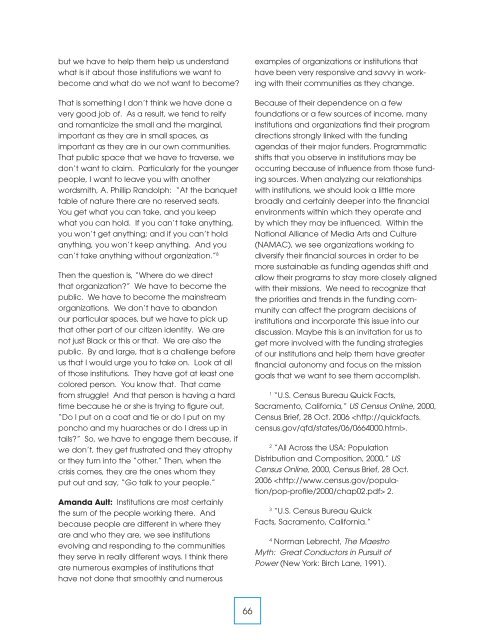The New Face of Arts Leadership in the West - westaf - The Western ...
The New Face of Arts Leadership in the West - westaf - The Western ...
The New Face of Arts Leadership in the West - westaf - The Western ...
Create successful ePaper yourself
Turn your PDF publications into a flip-book with our unique Google optimized e-Paper software.
ut we have to help <strong>the</strong>m help us understand<br />
what is it about those <strong>in</strong>stitutions we want to<br />
become and what do we not want to become?<br />
That is someth<strong>in</strong>g I don’t th<strong>in</strong>k we have done a<br />
very good job <strong>of</strong>. As a result, we tend to reify<br />
and romanticize <strong>the</strong> small and <strong>the</strong> marg<strong>in</strong>al,<br />
important as <strong>the</strong>y are <strong>in</strong> small spaces, as<br />
important as <strong>the</strong>y are <strong>in</strong> our own communities.<br />
That public space that we have to traverse, we<br />
don’t want to claim. Particularly for <strong>the</strong> younger<br />
people, I want to leave you with ano<strong>the</strong>r<br />
wordsmith, A. Phillip Randolph: “At <strong>the</strong> banquet<br />
table <strong>of</strong> nature <strong>the</strong>re are no reserved seats.<br />
You get what you can take, and you keep<br />
what you can hold. If you can’t take anyth<strong>in</strong>g,<br />
you won’t get anyth<strong>in</strong>g; and if you can’t hold<br />
anyth<strong>in</strong>g, you won’t keep anyth<strong>in</strong>g. And you<br />
can’t take anyth<strong>in</strong>g without organization.” 8<br />
<strong>The</strong>n <strong>the</strong> question is, “Where do we direct<br />
that organization?” We have to become <strong>the</strong><br />
public. We have to become <strong>the</strong> ma<strong>in</strong>stream<br />
organizations. We don’t have to abandon<br />
our particular spaces, but we have to pick up<br />
that o<strong>the</strong>r part <strong>of</strong> our citizen identity. We are<br />
not just Black or this or that. We are also <strong>the</strong><br />
public. By and large, that is a challenge before<br />
us that I would urge you to take on. Look at all<br />
<strong>of</strong> those <strong>in</strong>stitutions. <strong>The</strong>y have got at least one<br />
colored person. You know that. That came<br />
from struggle! And that person is hav<strong>in</strong>g a hard<br />
time because he or she is try<strong>in</strong>g to figure out,<br />
“Do I put on a coat and tie or do I put on my<br />
poncho and my huaraches or do I dress up <strong>in</strong><br />
tails?” So, we have to engage <strong>the</strong>m because, if<br />
we don’t, <strong>the</strong>y get frustrated and <strong>the</strong>y atrophy<br />
or <strong>the</strong>y turn <strong>in</strong>to <strong>the</strong> “o<strong>the</strong>r.” <strong>The</strong>n, when <strong>the</strong><br />
crisis comes, <strong>the</strong>y are <strong>the</strong> ones whom <strong>the</strong>y<br />
put out and say, “Go talk to your people.”<br />
Amanda Ault: Institutions are most certa<strong>in</strong>ly<br />
<strong>the</strong> sum <strong>of</strong> <strong>the</strong> people work<strong>in</strong>g <strong>the</strong>re. And<br />
because people are different <strong>in</strong> where <strong>the</strong>y<br />
are and who <strong>the</strong>y are, we see <strong>in</strong>stitutions<br />
evolv<strong>in</strong>g and respond<strong>in</strong>g to <strong>the</strong> communities<br />
<strong>the</strong>y serve <strong>in</strong> really different ways. I th<strong>in</strong>k <strong>the</strong>re<br />
are numerous examples <strong>of</strong> <strong>in</strong>stitutions that<br />
have not done that smoothly and numerous<br />
examples <strong>of</strong> organizations or <strong>in</strong>stitutions that<br />
have been very responsive and savvy <strong>in</strong> work<strong>in</strong>g<br />
with <strong>the</strong>ir communities as <strong>the</strong>y change.<br />
Because <strong>of</strong> <strong>the</strong>ir dependence on a few<br />
foundations or a few sources <strong>of</strong> <strong>in</strong>come, many<br />
<strong>in</strong>stitutions and organizations f<strong>in</strong>d <strong>the</strong>ir program<br />
directions strongly l<strong>in</strong>ked with <strong>the</strong> fund<strong>in</strong>g<br />
agendas <strong>of</strong> <strong>the</strong>ir major funders. Programmatic<br />
shifts that you observe <strong>in</strong> <strong>in</strong>stitutions may be<br />
occurr<strong>in</strong>g because <strong>of</strong> <strong>in</strong>fluence from those fund<strong>in</strong>g<br />
sources. When analyz<strong>in</strong>g our relationships<br />
with <strong>in</strong>stitutions, we should look a little more<br />
broadly and certa<strong>in</strong>ly deeper <strong>in</strong>to <strong>the</strong> f<strong>in</strong>ancial<br />
environments with<strong>in</strong> which <strong>the</strong>y operate and<br />
by which <strong>the</strong>y may be <strong>in</strong>fluenced. With<strong>in</strong> <strong>the</strong><br />
National Alliance <strong>of</strong> Media <strong>Arts</strong> and Culture<br />
(NAMAC), we see organizations work<strong>in</strong>g to<br />
diversify <strong>the</strong>ir f<strong>in</strong>ancial sources <strong>in</strong> order to be<br />
more susta<strong>in</strong>able as fund<strong>in</strong>g agendas shift and<br />
allow <strong>the</strong>ir programs to stay more closely aligned<br />
with <strong>the</strong>ir missions. We need to recognize that<br />
<strong>the</strong> priorities and trends <strong>in</strong> <strong>the</strong> fund<strong>in</strong>g community<br />
can affect <strong>the</strong> program decisions <strong>of</strong><br />
<strong>in</strong>stitutions and <strong>in</strong>corporate this issue <strong>in</strong>to our<br />
discussion. Maybe this is an <strong>in</strong>vitation for us to<br />
get more <strong>in</strong>volved with <strong>the</strong> fund<strong>in</strong>g strategies<br />
<strong>of</strong> our <strong>in</strong>stitutions and help <strong>the</strong>m have greater<br />
f<strong>in</strong>ancial autonomy and focus on <strong>the</strong> mission<br />
goals that we want to see <strong>the</strong>m accomplish.<br />
1<br />
“U.S. Census Bureau Quick Facts,<br />
Sacramento, California,” US Census Onl<strong>in</strong>e, 2000,<br />
Census Brief, 28 Oct. 2006 .<br />
2<br />
“All Across <strong>the</strong> USA: Population<br />
Distribution and Composition, 2000,” US<br />
Census Onl<strong>in</strong>e, 2000, Census Brief, 28 Oct.<br />
2006 <br />
2.<br />
3<br />
“U.S. Census Bureau Quick<br />
Facts, Sacramento, California.”<br />
4<br />
Norman Lebrecht, <strong>The</strong> Maestro<br />
Myth: Great Conductors <strong>in</strong> Pursuit <strong>of</strong><br />
Power (<strong>New</strong> York: Birch Lane, 1991).<br />
66


